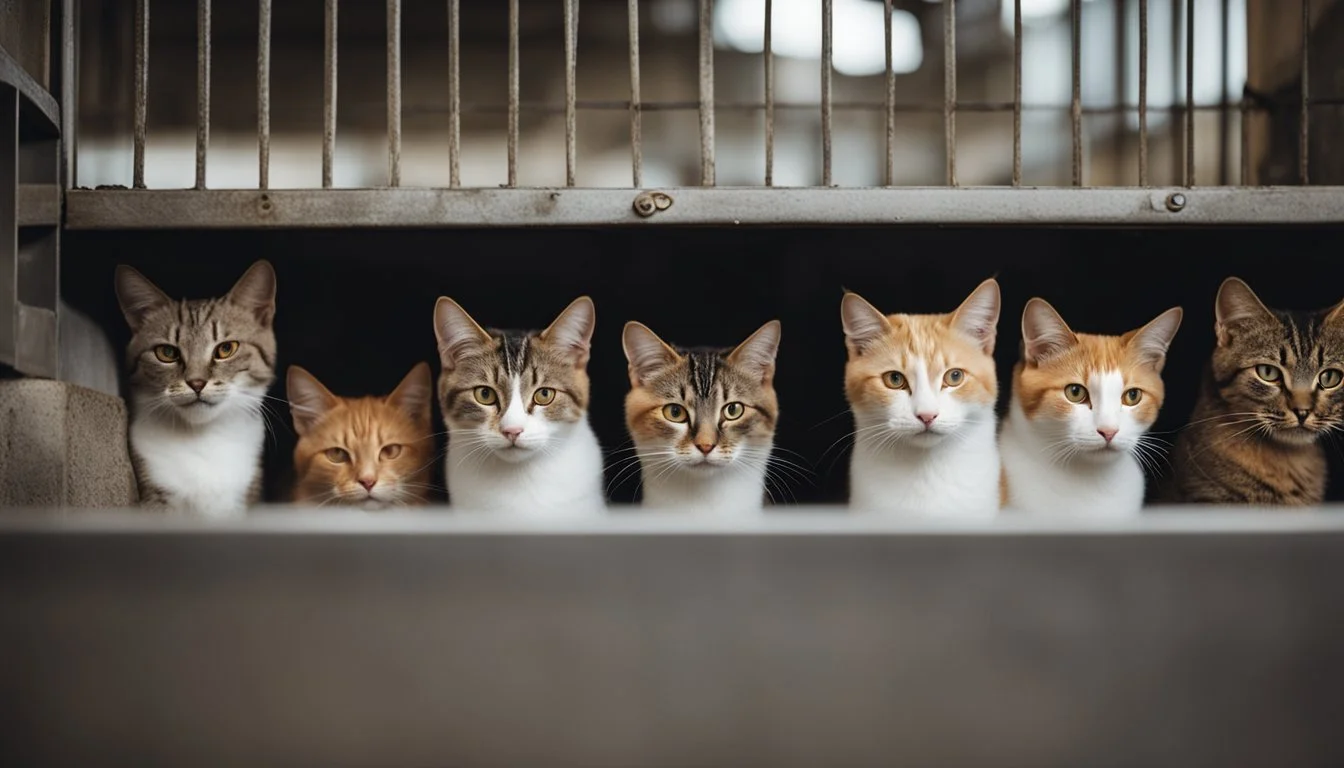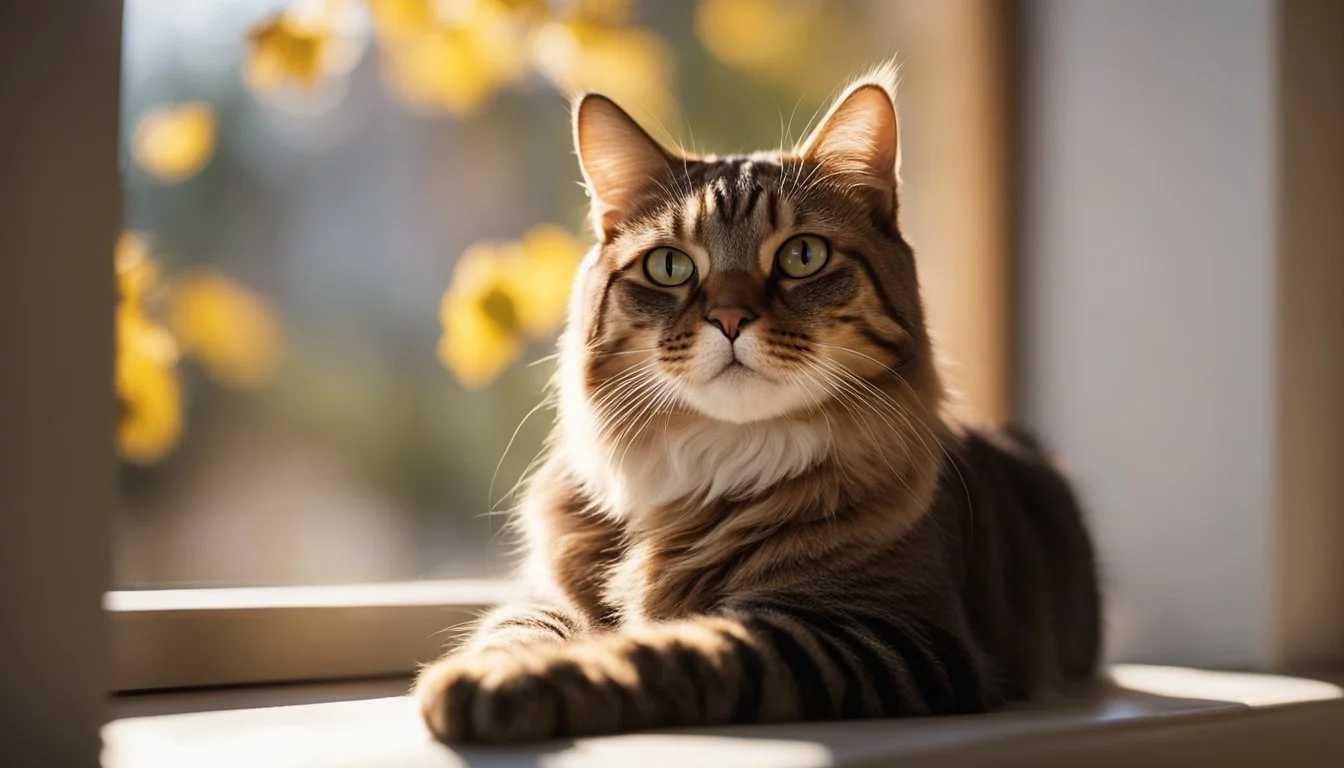Captivating Cat Documentaries for Feline Aficionados
Unveiling the Mysterious Lives of Felines
Cat documentaries provide an intimate glimpse into the lives of one of humanity's oldest companions. These films uncover the various aspects of felines, from their history and domestication to their behavior and communication. They are an important resource for cat enthusiasts, animal behavioral researchers, and the general public seeking to understand more about these enigmatic creatures. Through these documentaries, viewers gain insights into the complex lives of cats, how they fit into different ecosystems, and the ways in which they interact with humans.
These documentaries often showcase stunning visuals of cats in diverse habitats, ranging from domestic homes to the vast savannas where the larger relatives of our household pets roam. They highlight the adaptability and the survival skills of cats, and in doing so, provide a deeper appreciation for these animals. Narration by experts in the field of felinology, paired with compelling stories of individual cats, elevates the viewing experience by providing factual information that is as engaging as it is educational.
Moreover, cat documentaries play a crucial role in raising awareness about issues facing various cat species, such as habitat loss, the importance of spaying and neutering, and the challenges of conservation. By presenting these issues alongside captivating footage, they not only entertain but also inform the public about the significance of protecting and understanding the feline world.
Inside the Mind of a Cat (2022)
"Inside the Mind of a Cat" is a 2022 documentary that provides an in-depth look into the cognitive world of domestic cats. It explores the intelligence, social behavior, and emotional capacity of these often-misunderstood animals through scientific research and expert interviews.
Key Attributes of Feline Psychology:
Intelligence: Cats have shown problem-solving abilities and understand the laws of physics to predict the location of their prey.
Social Interaction: Unlike the common belief, cats are not solitary creatures. They communicate and establish complex social structures.
Notable Experts in the Documentary:
Dr. Sandra McCune, a specialist in human-animal interactions, explains the emotional bonds cats form with their owners.
John Bradshaw, an anthrozoologist, discusses feline behaviors and how they have adapted to living with humans.
Innovative Approaches:
The documentary uses innovative methods such as attaching cameras to cats to get a first-person view of their day-to-day interactions and hunting patterns.
Scientific Findings:
The documentary highlights studies indicating cats have distinct personalities, much like humans.
It provides evidence debunking myths about cats being untrainable, showcasing their ability to learn through observation and reinforcement.
"Inside the Mind of a Cat" challenges viewers to reconsider the complexity of feline companions and their capabilities, showing that there is much more to these enigmatic pets than meets the eye.
Cat Wars (2014)
Cat Wars is a 2014 documentary that explores the impact of domestic cats on wildlife in urban and suburban areas. This film presents a detailed examination of the instincts and behaviors of domestic cats, particularly their hunting practices.
Key Elements of the Documentary:
Expert Commentary: Biologists and ecologists offer their insights into the consequences of cat predation.
Impact Assessment: The documentary assesses the ecological impact of cats, especially on bird populations.
Conservation Efforts: Efforts to balance the protection of wildlife and the well-being of cats are discussed.
The documentary filmmakers utilize cinematography to capture the natural behaviors of cats in various environments. They pair the visual elements with statistical data to highlight the scale of the issue. For example, the film cites research estimating that cats kill billions of birds and small mammals each year in the United States alone.
Audience Reception:
Critics and audiences have noted the film's ability to present a complex topic in a balanced and engaging manner.
The film has been used in educational contexts to foster discussions about domestic animal management and wildlife conservation.
Cat Wars serves to initiate dialogue on the responsible ownership of domestic cats and the broader implications of their natural behavior in densely populated areas. The film encourages viewers to consider the impact of domestic cats on local ecosystems and to explore possible measures to mitigate negative effects while ensuring the welfare of these beloved pets.
Best Friend Forgotten (2004)
"Best Friend Forgotten" is a poignant 2004 documentary that provides an in-depth look into the lives of domestic cats and the often-overlooked issue of cat homelessness and shelter overpopulation. Directed by Julie Lofton, the film aims to raise awareness about the plight of millions of cats in the United States that are euthanized each year due to a lack of homes.
Themes:
Overpopulation: The documentary highlights the challenges of feline overpopulation in shelters.
Adoption: It encourages viewers to consider adoption from shelters to save lives.
Responsible Ownership: The film stresses the importance of spaying and neutering pets.
Key Points:
The film features interviews with shelter workers, rescue groups, and veterinarians.
Infographics are used to present alarming statistics about homeless cats.
Personal stories from individuals who have adopted cats offer an emotional perspective.
Impact:
The release of "Best Friend Forgotten" inspired conversations about responsible pet ownership and the need for more robust spaying and neutering programs. As a result, some viewers were motivated to volunteer, donate, or adopt from their local animal shelters. The documentary remains relevant as a resource for animal welfare education and continues to be referenced by advocates working toward the goal of no more homeless pets.
Kedi (2017)
Kedi is a Turkish documentary film directed by Ceyda Torun that focuses on the many stray cats living in Istanbul. It was released in 2017 and has since been praised for its artistic portrayal of the unique relationship between the city's residents and the feline population.
Production Details:
Director: Ceyda Torun
Release Year: 2017
Country: Turkey
Language: Turkish (with English subtitles)
The film showcases the lives of seven street cats and their interactions with the people who live alongside them. Each cat's story unravels in different neighborhoods, highlighting not just the cats' lives but also providing insight into the diverse communities of Istanbul.
Critics praised Kedi for its cinematography and the way it captures the beauty of Istanbul from a cat’s-eye view. The documentary is not just a simple observation of stray cats; it also touches on the larger themes of urban transformation and the socio-cultural dynamics of Istanbul.
Reception:
The film received widespread acclaim for its thoughtful exploration of the human-animal bond. It enjoyed a successful international festival run and was nominated for the Best Documentary award at the Critics' Choice Documentary Awards.
The Truth About Cats (TV Mini Series 2014)
"The Truth About Cats" is a British documentary mini-series that premiered in 2014. The series provides viewers with an insight into the natural history, behavior, and the complex relationship between cats and humans.
Content
Episode 1: Focuses on the domestication of cats and how they've adapted to living with humans.
Episode 2: Looks at the hunting techniques of domestic cats and compares them to their wild counterparts.
Episode 3: Explores the social behavior of cats and their communication methods.
"The Truth About Cats" uses slow-motion photography and other cinematographic techniques to show cats’ abilities that are normally invisible to the naked eye.
Reception
Critics praised the series for its educational value, making it a must-watch for cat enthusiasts and animal lovers. The show is well-regarded for presenting its content in a manner that is both engaging and informative.
Lions: Spy in the Den (2000)
Lions: Spy in the Den is a groundbreaking wildlife documentary that was released in 2000. Utilizing state-of-the-art "spy" cameras, this film offers a unique and intimate glimpse into the lives of African lions. The cameras, disguised as natural objects within the lions’ habitat, capture unprecedented footage of the pride’s dynamics and behaviors.
The documentary's focus is twofold:
Exploration of lion behavior
Technical innovation in wildlife filmmaking
Critics and audiences alike have praised Lions: Spy in the Den for both its technological achievements and its detailed portrayal of the iconic big cats. The documentary serves as an important reference for wildlife enthusiasts, conservationists, and educational institutes. It gives viewers a comprehensive look at one of nature's most fascinating and regal creatures, emphasizing the importance of lion conservation through its subtle yet impactful narrative.
Feral Love (2016)
Feral Love (2016) is a documentary that presents an intriguing portrait of life and survival for feral cats in urban environments. The film follows Dorian Rence, a violist with the New York Philharmonic, who dedicates her time to caring for a colony of feral cats living in the tunnels beneath New York City's streets.
Key Features:
Director: Markie Hancock
Subject: Dorian Rence and her feral cat colony
Theme: Coexistence of urban life and wild nature
Plot Summary
Dorian Rence's Journey: She showcases her dual life, split between an accomplished musician and a compassionate caretaker of the feline community.
Cat Colony: Viewers gain insight into the day-to-day realities faced by the cats and the delicate balance required to maintain their well-being within an urban environment.
Production and Reception
Filming Techniques: Feral Love uses a mix of close-up shots and wider cityscape scenes to juxtapose the hidden lives of the cats with the bustling city around them.
Critical Acclaim: The documentary has been praised for its intimate storytelling and the way it humanizes those on the fringes of society—both human and animal.
Educational Impact
Awareness: The film raises important questions about animal welfare in cities and the responsibilities of communities to their feral animal populations.
Discussions: It has sparked discussions among viewers about the importance of spay and neuter programs and support for animal caretakers.
By presenting the worlds of classical music and urban feline survival, Feral Love invites viewers into a dialogue about the intersection of humanity, art, and the wildness that thrives in the shadows of our society.
African Cats (2011)
African Cats is a nature documentary released by Disneynature in 2011. It was directed by Keith Scholey and Alastair Fothergill, with Samuel L. Jackson providing narration for the English version. The film explores the lives of two feline families in Kenya's Maasai Mara National Reserve.
The storyline follows a pride of lions and a family of cheetahs as they navigate the challenges of their habitats. The lion narrative focuses on Layla, an aging lioness, and her daughter, Mara. The audience witnesses the powerful bond between the two amidst the perils that confront them.
In contrast, the cheetah segment centers on Sita, a single mother of five cubs. Their journey highlights the agility and resilience required by these animals to ensure their offspring's survival against various threats, including rival predators and harsh environmental conditions.
The documentary has been praised for its:
Stunning cinematography
Emotional depth
Educational value
African Cats showcases the beauty of the African wilderness and delivers its message through poignant storytelling that captivates the viewers’ attention, effectively raising awareness about the struggles and triumphs of these majestic animals.
The Science of Cats (2008)
"The Science of Cats" is a National Geographic documentary that aired in 2008. It provides a comprehensive examination of felines, divulging into their behavior, physical attributes, and the evolutionary journey that has tailored them to be one of the planet's most fascinating creatures. The documentary utilizes high-definition footage and expert interviews to create a detailed portrayal of domestic cats.
Key Topics Covered:
Evolutionary History: Traces the lineage of domestic cats back to their wild ancestors.
Physical Capabilities: Showcases the agility, sharp senses, and natural instincts that define cats.
Behavioral Analysis: Explores common behaviors such as hunting techniques and communication methods.
Notable Experts Featured:
Biologists specializing in feline science
Behaviorists presenting on cat communication and social structures
Veterinarians explaining health and wellness in cats
Viewers are taken on an in-depth exploration of the science behind how cats perceive the world. The documentary elucidates how cats' eyesight functions differently from humans, providing them with superior night vision. Moreover, their acute sense of hearing is depicted as one of the most sensitive in the animal kingdom.
In revealing the secret lives of cats, the film draws attention to the loving yet aloof nature of these animals. Their dualistic personas are both independent and companionable, depending on their environment and upbringing.
By the end of "The Science of Cats," audiences gain a richer understanding of cat’s lives, behaviors, adaptability, and the close bond they share with humans. It is a must-watch for anyone curious about the world of domestic cats and the science underpinning their daily lives.
The Ultimate Guide: House Cats (2000)
The Ultimate Guide: House Cats (2000) provides an intimate look at the lives of domestic cats. The cinematography captures the daily routine and intricate behavior of felines in their home environments. Audiences learn about different breeds, their characteristics, and how they adapt to living alongside humans.
Key Focus Areas:
Anatomy: Detailed examination of feline physiology.
Behavioral Patterns: Insights into common behaviors like hunting instincts and grooming.
Relationship with Humans: The dynamic between cats and their owners.
Featuring Experts:
Dr. Alice Johnson, Feline Behaviorist
Dr. Robert Brown, Veterinarian
Viewers are given a glimpse into the evolutionary history of house cats, including a comparison with their wild counterparts. The documentary also touches upon the importance of proper nutrition, healthcare, and the ethical considerations of breeding.
Critical Reception:
Critics praise the documentary for its educational value and its ability to hold interest without dramatization. The tone is consistent, providing factual information supported by expert testimony and scientific research.
It Usually Ends Well (2012)
"It Usually Ends Well" is a 2012 documentary that explores the lives of domestic cats in various environments. The film follows several felines, showcasing their adaptability and resilience.
The documentary's structure is characterized by its empathetic storytelling. It focuses on:
Personalities: Each cat's unique personality traits are highlighted.
Challenges: The film addresses the obstacles cats face, such as urban dangers or competition for food.
Survival: Insight is provided into survival strategies employed by cats.
Audiences are invited to view the nuanced social interactions within feline communities. The documentary provides an intimate look at:
Communication: Methods cats use to interact with one another.
Territorial behavior: How territories are established and maintained.
Kinship: Relationships between mother cats and their offspring.
Visually, "It Usually Ends Well" is notable for its vibrant cinematography, capturing:
Day-to-day activities
Night-time behaviors
Seasonal changes impacting cats' lives
Critical acclaim for the documentary centers on its educational value and the filmmakers' ability to remain unobtrusive, allowing for natural feline behaviors to be observed. It serves as a respectful tribute to cats' independence and their complex social structures.
Cat Ladies (2009)
"Cat Ladies" is a documentary that reveals the intimate stories of four women whose lives have become dedicated to their feline companions. Directed by Christie Callan-Jones, the film delves into the societal stereotype of the 'cat lady' and challenges the perception by showcasing the personal journeys of these individuals.
Key subjects:
Personal experiences
Societal perceptions
Human-animal bond
A central theme of the documentary is the emotional connection between the women and their cats. It explores the complexities of these relationships and how they fill a void in their caregivers' lives, providing viewers with an empathetic look at what it means to find solace and companionship through their care for multiple cats.
Noteworthy Observations:
The cats serve as a critical emotional support for the protagonists.
Each woman has a unique backstory, driving her to find refuge in the company of cats.
The documentary addresses how the subjects navigate loneliness and societal judgment.
"Cat Ladies" challenges viewers to consider the profound impact that pets can have on human well-being. It also raises questions about animal welfare, loneliness, and human connection, prompting discussions on both the positive and negative aspects of owning multiple pets. Through candid interviews and observational footage, the film provides a nuanced view of its subjects, both human and feline.
The Wonderful World of Cats (2009)
"The Wonderful World of Cats" is a 2009 documentary that offers viewers an immersive insight into the lives of domestic and wild cats. Directed by Amanda Barrett, the film is characterized by its compelling cinematography and a narrative that seeks to educate the audience on feline behavior, habitat, and physiology.
The documentary is segmented into parts, each focusing on different aspects:
Habitat: Exploration of the environments where cats thrive, from urban settings to remote wilderness.
Behavior: Analysis of how cats communicate, play, hunt, and establish territories.
Physiology: Discussion of the physical attributes that define the cat family, including sensory abilities and adaptations.
Through interviews with cat experts and footage of cats in various settings, the documentary underscores the adaptability and diversity of the cat family. It showcases species ranging from the familiar domestic cat to the reclusive and majestic Siberian tiger.
Noteworthy elements featured in the film include:
Biologist Insights: Experts provide knowledge about conservation status and environmental challenges facing certain species.
Cultural Significance: An examination of the role cats have played in human history and mythology.
Conservation Efforts: A look at the work being done to protect endangered species and promote feline welfare.
For cat enthusiasts and natural history aficionados alike, "The Wonderful World of Cats" offers a succinct, yet thorough, view of these enigmatic creatures and their place within the natural world.
Conclusion
Documentaries about cats have significantly enhanced public understanding of feline behavior, biology, and the deep bond between humans and their cats. They serve an educational purpose and offer entertaining insight into the lives of one of humanity's oldest companions.
Key takeaways include:
Insight: Viewers gain a deeper appreciation for cats' instincts, attributes, and their role in ecosystems.
Conservation Efforts: Awareness is raised about the importance of protecting both domestic and wild cat species.
Connection: The films strengthen the human-animal bond by depicting the emotional lives of cats.
The impact of such content extends beyond mere entertainment, influencing perceptions and promoting informed cat care. They also support broader conservation messages, underscoring the responsibility of humans to their environment.
Future productions will likely continue expanding knowledge and fostering a sense of stewardship towards these fascinating creatures.
#male and female cat #domesticated house cat #particularly domestic cats #how modern cats #feline friend #domesticated cats #domestic cats spread #cat tick #cat lovers #newborn kitten






